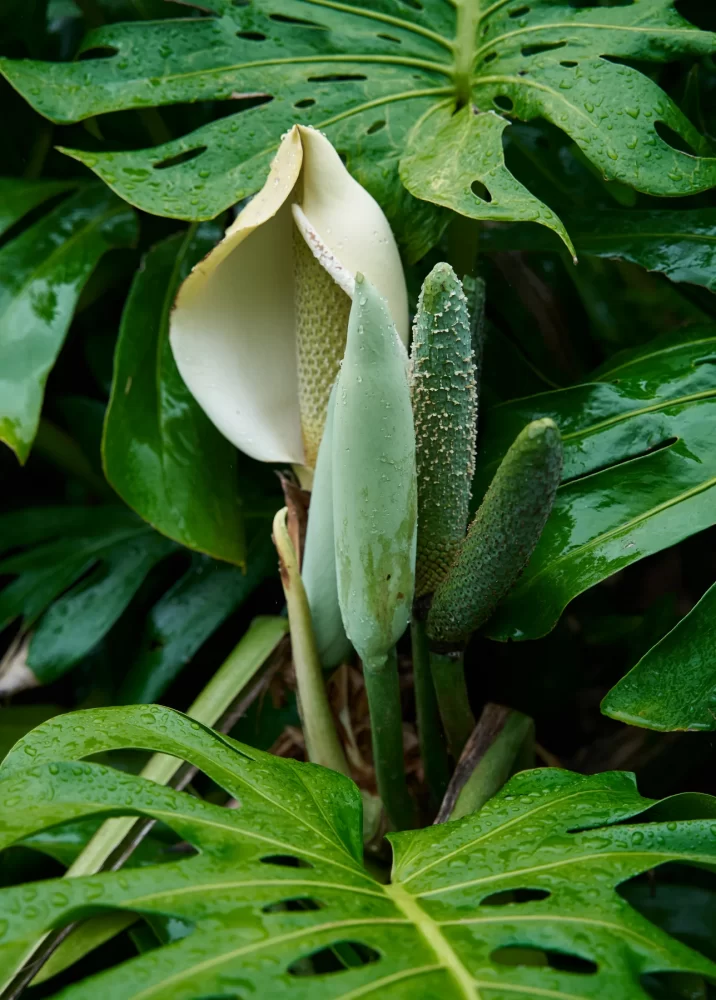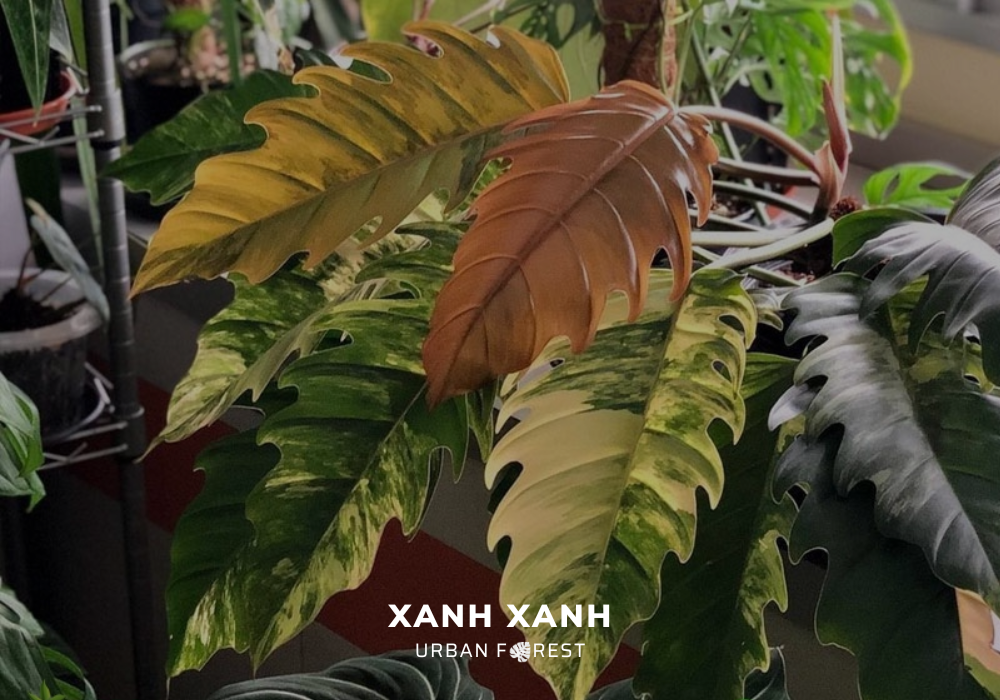Monstera is a common rare plant that originated in Central America. It is known for its large, perforated leaves, but did you know that Monstera plant also produces a delicious and exotic fruit? But what does Monstera fruit taste like? Is it good to eat? And how can you encourage your Monstera plant to produce fruit? Find out the answers to these questions and more in Xanh Xanh Urban Forest’s blog to Monstera fruit.
Table of Contents
1. Introduction to Monstera
Because of their special, tropical look, Monstera plants are beloved by indoor enthusiasts. Large, pierced leaves characterize these plants, which are native to Central and South America. Although native Monsteras can reach remarkable heights of 20 feet, these adaptable gems are surprisingly low-maintenance and easily connect to a wide range of homes. So, whether your space boasts high ceilings or cozy corners, there’s a Monstera for you!

Monstera’s foliage is what gives it its enchanting appeal. Usually a rich green color, the leaves might surprise you with flashes of cream, white, or yellow. Unlike any other leaf, these have delightful holes that are thought to improve their ability to photosynthesise in the shaded sunshine of their forest surroundings.
For indoor gardeners seeking a touch of the tropics, Monstera is a dream come true. Don’t let their fancy looks fool you! Monstera plants are actually super easy to care for and do well in all sorts of places inside your house. So, if you want a cool and eye-catching plant to spruce up your space, get yourself a Monstera!
2. What does Monstera fruit look like?
The Monstera fruit is a hidden treasure of the Monstera plant. It is a bright green, corncob-like fruit that can grow up to 12 inches long. These scales delicately peel back as it ages to reveal creamy, custard-like flesh below.

The sun-kissed yellow or green color of ripe Monstera fruit attests to its wonderful flavor. A symphony of tropical notes, reminiscent of pineapple, banana, and mango, explodes in its flavor. This exotic delight is full of vitamins A and C and provides a satisfying and tasty experience. If you own a Monstera plant, you should try the fruit, which is a tasty and unique delicacy.
3. When does Monstera fruit ripen?
The wait for Monstera fruit is a patient one, its journey to ripeness influenced by several elements. The period of transition may take 6 to 9 months, relying on a number of factors, including the age of the plant, the climate in which it grows, and the particular variety. But it could take a year for some types to grow to their best.
Age is a key factor in this fruity equation. It will take younger Monsteras longer to yield than its more seasoned counterparts because they are still getting established. Generally speaking, you should not expect a bountiful harvest until the plant is at least three years old.
The surrounding environment also plays its part. Basked in warm and humid conditions, Monstera fruit ripens more quickly compared to cooler, drier climates. So, if you’re eager to enjoy the sweet reward of your patience, consider giving your plant a tropical vacation!

Finally, the variety of Monstera also affects the ripening time. Some varieties of Monstera fruit ripen more quickly than others.
The fruit will start to turn yellow or green when it is ripe. The yellowing will begin at the base of the fruit and gradually spread to the rest of the fruit. The fruit will also become softer and more pliable when it is ripe. The scales on the fruit will begin to separate. The fruit will become soft and easily pierced with a toothpick.
If you are unsure whether Monstera fruit is ripe, it is best to err on the side of caution and wait a few more days before harvesting.
4. Is it good for a Monstera plant to produce fruit?
Whether or not it is good for a Monstera plant to produce fruit is a matter of personal preference. There are both pros and cons to fruit production.
Many gardeners find satisfaction in seeing fruits, which are indicative of a strong, healthy plant. They are the fruits of nature’s labor for offering the ideal ratio of sunlight, water, and food. But hang on! Fruits have two sides to them as well. They can draw unwelcome pests and illnesses, and their weight can burden the plant and make it unsightly.
So, should you promote fruit-bearing on your plant? As with most things in life, the solution isn’t clear-cut. It all depends on your priorities and gardening aspirations. Which is more important to you: the pure beauty of your plant or the satisfaction of a plentiful harvest? Are you ready to handle additional upkeep and perhaps pests? You get to make the final decision, dear gardener!
5. How to encourage Monstera fruit production?
Dreaming of savoring the unique taste of Monstera fruit? It’s closer than you think! With a little TLC, you can transform your leafy friend into a fruit-bearing wonder. Here’s how:
Sunbathe with purpose: Just like humans basking on the beach, Monsteras crave their sunshine fix. Aim for at least 6 daily hours of bright, indirect light. Northern dwellers, fear not! Supplement with grow lights to keep your plant feeling tropical.

Feed the beast: Like any champion athlete, your Monstera needs fertilizer to perform. A balanced blend, applied regularly, will fuel its fruity ambitions. Choose between liquid or slow-release options, letting your personal preference reign supreme.
Drainage dance: Water is essential, but too much can lead to soggy soil and unhappy roots. Select a well-draining potting mix, letting excess water pirouette away to avoid a root-rotting tango.
Healthy habits: Think of it like prepping for a marathon. Keep your plant squeaky clean, pest-free, and disease-free. Remember, healthy plants are happy fruit producers!
Lend a supporting hand: As your Monstera’s fruit matures, it can get a bit top-heavy. Give it a helping hand with a sturdy support structure, preventing drooping branches and fruit-tastic flops.
If you follow these tips, you may be rewarded with a delicious and exotic harvest of Monstera fruit.
6. Final thoughts
Have a Monstera plant sitting pretty in your home? Well, prepare to unlock its hidden treasure! This tropical beauty doesn’t just boast stunning foliage; it also bears a delectable fruit worth savoring. Yes, you read that right! The Monstera plant can surprise you with a fruit that’s both exotically delicious and surprisingly easy to cultivate. With just a touch of your green thumb and some tender loving care, you can coax your Monstera into producing this unique and flavorful treat. So, get ready to be amazed by the bounty your plant has to offer!
Xanh Xanh Urban Forest hopes that you found this blog article to be useful and educational. Please use the following to contact us with any questions:





